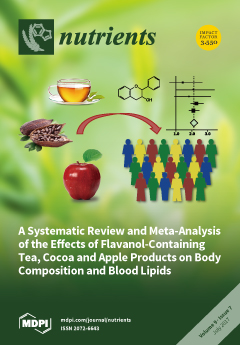1
Research Group on Quality, Safety and Bioactivity of Plant Foods, Campus de Espinardo, Centro de Edafologia y Biologia Aplicada del Segura-Consejo Superior de Investigaciones Científicas (CEBAS-CSIC), P.O. Box 164, 30100 Murcia, Spain
2
Human Nutrition, School of Medicine, Dentistry and Nursing, College of Medical, Veterinary and Life Sciences, University of Glasgow, Glasgow G31 2ER, UK
3
Polytechnic Institute of Santarem, Escola Superior Agrária (ESA), Department of Food Technology, Biotechnology and Nutrition, 2001-904 Santarém, Portugal
4
Human Nutrition Unit, Department of Food & Drug, University of Parma, 43125 Parma, Italy
5
Biomarkers and Nutrimetabolomic Laboratory, Department of Nutrition, Food Sciences and Gastronomy, University of Barcelona, 08028 Barcelona, Spain
6
CIBER de Fragilidad y Envejecimiento Saludable (CIBERFES), Instituto de Salud Carlos III, 08028 Barcelona, Spain
7
Division of Diabetes and Nutritional Sciences, King’s College London, London SE1 9NH, UK
8
Institute of Food and Health, School of Agriculture and Food Science, University College Dublin (UCD), Belfield, Dublin 4, Ireland
9
U1167-RID-AGE-Facteurs de risque et Déterminants Moléculaires des Maladies Liées au Vieillissement, University Lille, Institut National de la Santé et de la Recherche Médicale (INSERM), Centre Hospitalier Universitaire (CHU) Lille, Institut Pasteur de Lille, F-59000 Lille, France
10
National Research Council (CNR), Institute of Clinical Physiology, 73100 Lecce, Italy
11
Department of Basic Psychology & Methodology, Faculty of Psychology, University of Murcia, 30100 Murcia, Spain
12
Institut National de la Recherche Agronomique (INRA), Human Nutrition Unit, Université Clermont Auvergne (UCA), Centre de Recherches en Nutrition Humaine (CRNH) Auvergne, F-63000 Clermont-Ferrand, France
add
Show full affiliation list
remove
Hide full affiliation list
Abstract
Several randomized controlled trials (RCTs) and meta-analyses support the benefits of flavanols on cardiometabolic health, but the factors affecting variability in the responses to these compounds have not been properly assessed. The objectives of this meta-analysis were to systematically collect the RCTs-based-evidence of
[...] Read more.
Several randomized controlled trials (RCTs) and meta-analyses support the benefits of flavanols on cardiometabolic health, but the factors affecting variability in the responses to these compounds have not been properly assessed. The objectives of this meta-analysis were to systematically collect the RCTs-based-evidence of the effects of flavanol-containing tea, cocoa and apple products on selected biomarkers of cardiometabolic risk and to explore the influence of various factors on the variability in the responses to the consumption of these products. A total of 120 RCTs were selected. Despite a high heterogeneity, the intake of the flavanol-containing products was associated using a random model with changes (reported as standardized difference in means (SDM)) in body mass index (−0.15,
p < 0.001), waist circumference (−0.29,
p < 0.001), total-cholesterol (−0.21,
p < 0.001), LDL-cholesterol (−0.23,
p < 0.001), and triacylglycerides (−0.11,
p =
0.027), and with an increase of HDL-cholesterol (0.15,
p = 0.005). Through subgroup analyses, we showed the influence of baseline-BMI, sex, source/form of administration, medication and country of investigation on some of the outcome measures and suggest that flavanols may be more effective in specific subgroups such as those with a BMI ≥ 25.0 kg/m
2, non-medicated individuals or by specifically using tea products. This meta-analysis provides the first robust evidence of the effects induced by the consumption of flavanol-containing tea, cocoa and apple products on weight and lipid biomarkers and shows the influence of various factors that can affect their bioefficacy in humans. Of note, some of these effects are quantitatively comparable to those produced by drugs, life-style changes or other natural products. Further, RCTs in well-characterized populations are required to fully comprehend the factors affecting inter-individual responses to flavanol and thereby improve flavanols efficacy in the prevention of cardiometabolic disorders.
Full article






